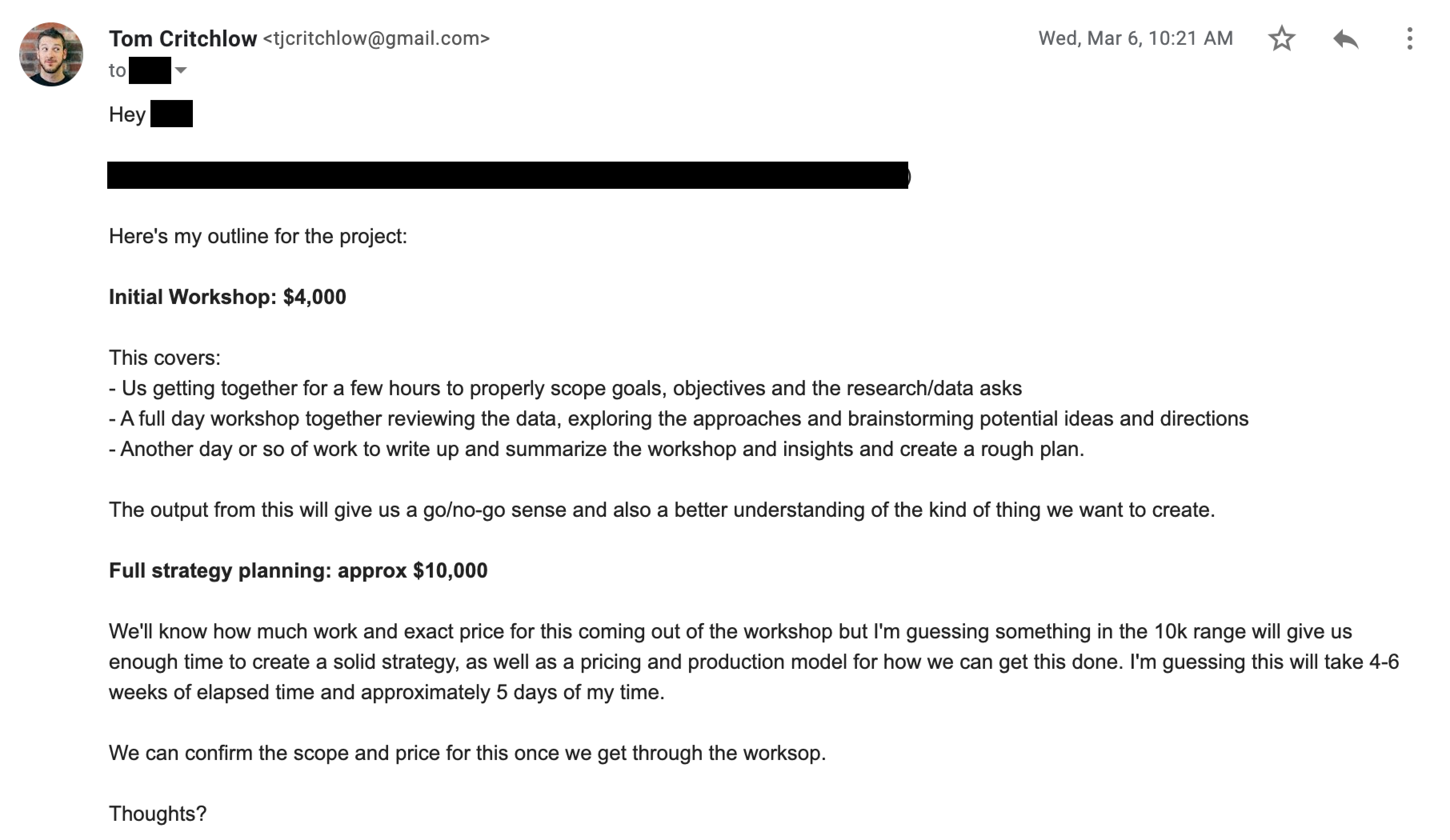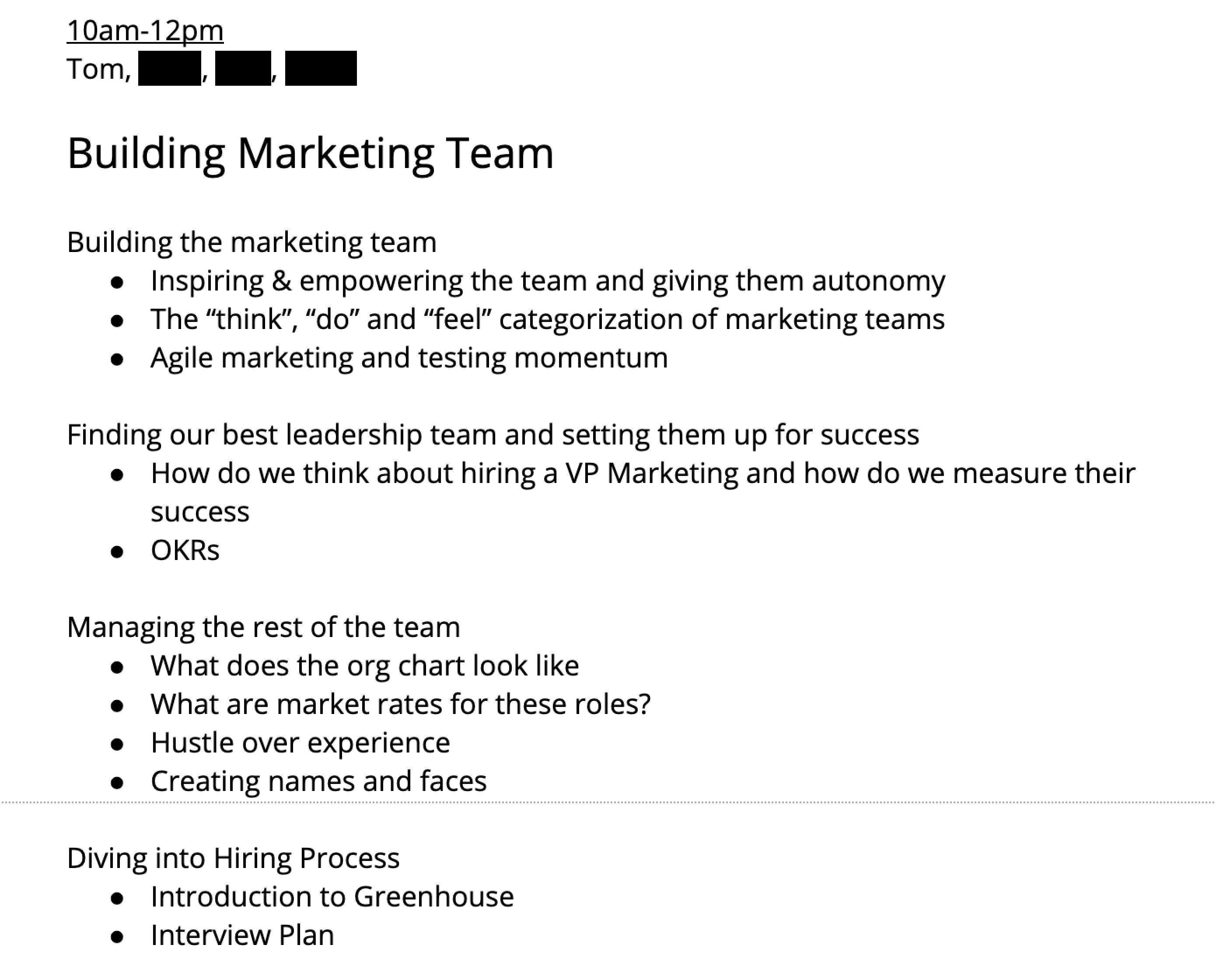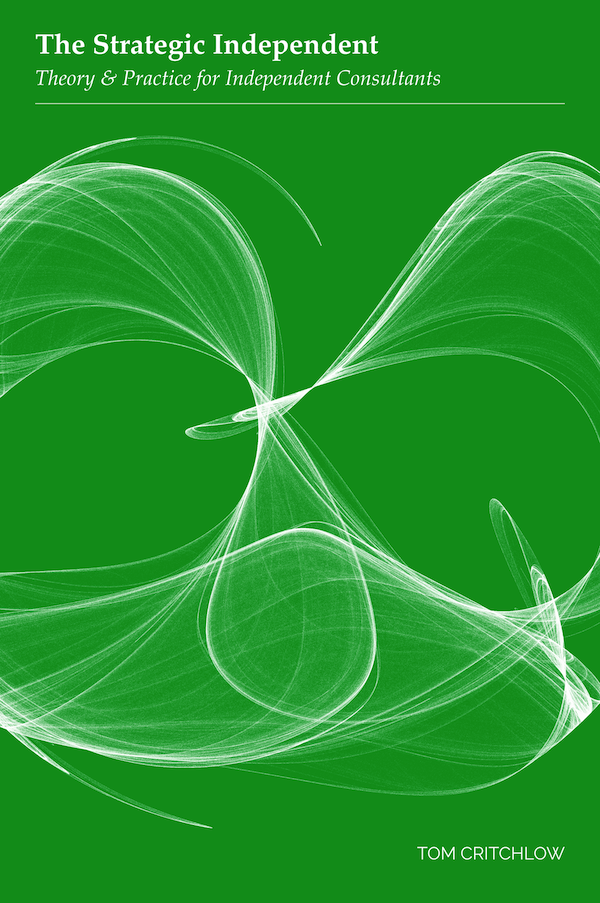Workshops as Portals
And how to create clarity in consulting work
Selling consulting work is tricky - there’s a foundational inside/outside problem for consultants; how do you know enough about the client or their problems to put together a proposal?
Essentially you’re looking for ways to “bridge” from outside to inside. If only you could open a portal inside their organization and take a peek…
Turns out you can - by selling a workshop.
My default response to all new clients over the past few years is to sell a workshop, and it’s helped me sell better work that retains for longer.
“Workshops” can mean many different things but in this post I’m going to talk specifically about designing workshops for clarity - to portal inside the client’s business and create a bridge to long-term retained work.
The trick is not to design these workshops to “solve” anything but rather to think of them as jam-sessions to create clarity.
Imagine attempting to “solve” brand strategy in a one-day workshop? Likely impossible. But you can create clarity.
And clarity is valuable - so you can charge well for these workshops if you set them up right.
In this post:
- Why clarity is important for both consultant and client
- How to structure a workshop for outcomes, not happiness
- A series of conversation prompts to run effective jam-sessions
- Why you shouldn’t undersell yourself (aka selling one day’s work for $4,000)
- Some examples from my own work
First though, some narrative theory…
In media res
“In media res” literally means “in the middle of things” and it’s a narrative device that movies and books use all the time. Open with the protagonist leaping through the air between buildings, tentacles grasping mid-air behind… and then figure out a way to explain what’s going on later.
People will have an appetite for the boring stuff once you tease the action.
Consulting works this way too - both client and consultant yearn for in media res - i.e. a sense of how it’s going to feel to work together.
The client thinks:
- Can the consultant help us with these specific problems?
- Does the consultant know anything?
- Will our work-styles match or clash?
- Will this consultant be reliable?
- How do I persuade my boss to work with the consultant?
The consultant thinks:
- Is there a big enough project here to justify a consulting engagement?
- What are their real problems and can I solve them?
- What are their team dynamics and personalities and can I work with them?
- Will our work-styles match or clash?
There’s a foundational inside/outside problem for consultants - how do you know enough about the client to even put together a proposal? Can you trust clients to self-report their problems accurately? How do you get access as an outsider?
But, typically, before you can get there you need to battle through a conversation about price and contracts…
So how do you get some sense of in media res for both client and consultant before wading through contract negotiation?
Selling Portal Workshops
The trick to navigating this chicken/egg problem of contracts/context is to respond to a proposal with an initial workshop. A portal workshop.
Here’s a real example:

The trick is that a “small” piece of work (more on pricing later) is often an easier sell than a full retainer or larger project scope. So you can skip around the contract/context question to portal into the client’s reality and create some clarity.
The eagle-eyed among you might notice that the “scope” for this workshop is incredibly loose. These aren’t workshops that have a ton of programming and heavy agenda - they should be more jam session than pre-programmed workshop.
Jam Sessions
“Workshop” is a difficult word. People mean lots of different things and workshops can come in many flavors1.
For me, these initial workshops work best as collaborative working sessions rather than pre-programmed facilitation. Depending on the client’s comfort I’ll prepare anything from a four bullet point agenda to a little prep-deck to walk through, but I find the more I pull together an agenda the worse the workshop is.
Invariably, the lived experience feels more like a jam session than a guided workshop. Free jazz not pop. Experience not performance. Collaborative not guided.
Why take this approach?
Let’s recap the goals - with this portal into the client’s reality we’re trying to:
- Get comfortable “sparring”2 with the client
- Make the client feel that you’ll listen closely
- Understand the real problems and make sure they will put budget against solving them
- Demonstrate to the client that you can help
- Understand the client’s team dynamics
- Understand the context for the work properly (i.e. what is the work, who are the people, why now)
- Identify client’s blind spots (their unknown unknowns)
So many unknowns!
Without room for improvisation, sparring and discussion you won’t get enough of the context that you’re after.
And typically I restrict these sessions to no more than 5-6 people - beyond that it’s hard to hear the individual voices and people start to put on masks and behave differently around each other. If you want the truth, keep the group small.
Conversation prompts for running an effective jam session
Just because it’s a free-jam session doesn’t mean you can’t prepare and think ahead to how you’ll explore the client’s reality.
Here’s a few conversation prompts, guides and pointers for running an effective jam session - all designed to gain clarity:
- Restate the situation and goals as the first thing. Be sure to tease out any discrepancies or inconsistencies in the client’s answer. Push for specifics and don’t plaster over the cracks.
- The core interaction of the day is question/response, question/response. Don’t try to be linear, instead be recursive - never settle on the first answer but keep following threads until you get somewhere. Always looks for the next logical question that bridges from the last.
- Don’t look for smart questions, look for dumb questions. “Ok, this might be a stupid question but why don’t we just build this the way we built the last one?”. My favorite dumb question: “Seems like you have a good handle on the problem and the solution - what do you need me for?”
- Create plenty of “what ifs” - “Let’s just pretend for a moment we have the VP marketing hired, what projects do we think they’d be responsible for?”
- Be frank and to the point. “Do you believe you have the team to execute that plan? Where are the gaps?” or “Why won’t the CEO sign off on the budget?”
- Don’t be afraid to “solve” small problems in the room - especially those where you have some domain expertise and the credibility for people to trust your answer.
- DO be afraid to solve big problems in the room. Even if you think you have a clear solution… you don’t. At best you come up with a “solution” that could work in theory, but fails to get sold in and implemented or is too generic and actually misses some context.. At worst, your “solution” is no solution at all, is a failed solution they have already rejected, or gets taken forward as an apparent solution that falls apart later.
- Aggressively reframe problems “ok, let’s say this another way” really help get to the real issues underlying the stated problems
- Keep a running list of discrete problems. “OK, so we’ve agreed that the marketing dashboard isn’t working and needs rebuilding, analytics needs an audit as we’re not confident in it, some basic keyword research would help guide your editorial team and there’s some SEO knowledge gaps in your tech team so we should run some training” - this list of problems is going to help you scope the ongoing retainer after the workshop.
- Dead time is the ultimate goal. Pauses to think are the whole point. Questions where there’s no trite easy answer are powerful. Let them settle in and leave the room quiet for a bit.
Engineer for outcomes not optimism
My favorite way to think about any workshop is that you’re here to get productive outcomes, not have a nice time.
This is especially true for small jam sessions like this - sure we want to know and understand that we can work together but I don’t want to hold your hand and I don’t want to shy away from questioning your thinking.
So think ahead of time what the potential outcomes are and what you need to know - and drive towards it.
Clients will more readily hire you after an exhausting and challenging workshop where everyone feels like progress was made, over a feel-good workshop where all the boxes were ticked and post-its pinned up, but ultimately no one felt like they were much further along.
Workshops for selling open-ended retainers
So these portal workshops help bridge the outside/inside of the consultant/client realities but what happens after the workshop?
Here are some unsurprising but important outcomes:
- A personal relationship with the client contact
- A shared experience of working together (in media res)
- A richer understanding and awareness of the client’s context, the project’s context and the real problems the client faces
- A sketch and conceptual framework for how to solve the problems (or at least where to start looking for solutions)
But here’s one surprising outcome:
You can get away with a much lighter SOW (statement of work) after a good workshop
I’ve heard from other indie consultants and freelancers that sometimes putting together a scope or SOW and getting it approved by the client is a real point of pain - even once you’re aligned on the project and scope!
The negotiation is hard when you’re lacking trust and context and both parties are trying to anticipate what kinds of work and what level of detail is needed.
But in my experience once you’ve been in a room together for a day or two negotiating a scope becomes much simpler - there’s some trust set up and context for the work that means you can write a scope such as:
- Tom to be on site to help with audience development 2 days a week
This solves a lot of headaches3!
$4,000 days - A note on pricing these workshops
It’s crucial not to undersell yourself for these workshops. On the one hand you could argue that since this workshop is designed to sell a long term retainer you could discount it or even deliver it for free. Certainly the economics justify it.
Except - this is your best chance to anchor the client on your rates. If you undersell yourself in this workshop then the chances are you’re not going to get the rate you want for the ongoing retainer.
So - I recommend taking your day rate and doubling it for these workshops. So if your day rate is $2,000 / day, a one-day workshop would be $4,000.
Since this is a relatively small amount of money (though a high day rate!) it’s often more straightforward to get sign off. And I often sell these by explaining there’s prep work, research and some kind of debrief follow-up.
But here’s a word of caution - if you follow this advice you might end up selling an “expensive” workshop and then feel anxious about the free-jam nature of it - so you decide to over-plan and over-engineer the workshop and end up settling on a more structured workshop that doesn’t deliver.
To get around this thinking - let’s take an example. Let’s say you’re an expert in brand positioning. A client is having some trouble thinking about brand marketing (maybe they’re not doing much of it right now? Or they’re thinking of hiring a head of brand?) so they engage you for a day’s workshop.
Now, stop and think - do you truly believe that this client’s brand marketing challenges can be solved in a day? Brand marketing is expensive! It’s slow! There’s no way you can solve this in one day.
So what are you actually selling here? Clarity. And clarity is valuable!
Four interesting anecdotes from my own work
It’s hard to give real case studies for these workshops because so much of the work is left in the room - improv and spontaneous. But here are four interesting memories from recent work:
Five figures for two days
The most expensive workshop I’ve ever done was sold on an initial phone call and a one page Google Doc agenda outline. Here’s a sample to show you how bare bones the agenda was:

Following this workshop we settled on a monthly retainer and I ended up working with them for over two years.
A workshop that went sideways
One of my most fun workshops was a one day workshop where the very first question of the day derailed the whole agenda.
Five people were in the room and I asked them to go around the room and explain the project in their own words. By the time we’d gone around the table there was such an obvious mismatch in expectations that we spent the whole day unpacking it - what was supposed to be an audience development workshop became more of an organizational and alignment workshop.
In hindsight I think I played the role of group therapy more than consultant for this one. A rigid agenda or trying to follow a script too closely would have missed the value of this freestyle session that largely exposed and clarified problems rather than solved anything.
Coming out of this workshop we collaborated on a few one off projects but it was clear to me that an ongoing retainer didn’t make sense unless we resolved these tensions internally at the client.
A workshop full of silence
Recently I ran a one day workshop with lots of dead air. Awkward questions that seemed to hang in the air. At the time this workshop felt stilted, strained and perhaps unproductive - why couldn’t we get to the answers we were trying to drive towards?
Towards the end of the day and in the follow up it became clear that when the client confidently stated they “knew the industry” and understood the influencers in the space they actually had a very light grasp of the players and their business, their strengths and how they functioned. They were trying to develop a strategy while missing the context they were operating in.
This ultimately informed almost the entire output from the workshop - the insight that more in-depth research was needed to understand the landscape more clearly and fundamentally before they could develop a strategy.
WeWork(shop)
Portals are tricky things. And sometimes you get stuck in-between dimensions4.
Here’s an email I got after running a two-day workshop last year:

In fact, I will very often deliberately use the word “us” and “we” rather than “you” when talking to clients to help establish a partner-style relationship rather than agency/client relationship.
That said - clearly in this case it didn’t land right, but I’d probably do the same again given the chance!
Conclusion
I’m sure there are many other ways to bridge the gap to the client’s reality but if there’s one thing to remember, it’s that clarity is crucial to good work.
So look for ways to build context and clarity by design into your workflow - either in how you get new clients, how you close them or the kinds of work that you do.
Whatever kind of client you’re looking for I’d encourage you to think about how you can skip to the action - is there a way to stage a mini work session and feel what it’s like to work together before committing?
And don’t be afraid to charge well for this work - clarity is valuable! And it sets the stage for any future work.
So construct a portal into your client’s reality and play some jazz.
-
See this post from Howard on the three flavors of workshops ↩
-
More on what sparring means from Venkatesh on his site and in this twitter thread. ↩
-
Note: If you’re finding that clients aren’t receptive to the idea of workshops then it could well be a symptom of a different problem - that is not getting warm leads for senior work. If clients already have you in a box and/or you’re pitching against other vendors then this workshop approach could fail. ↩

